 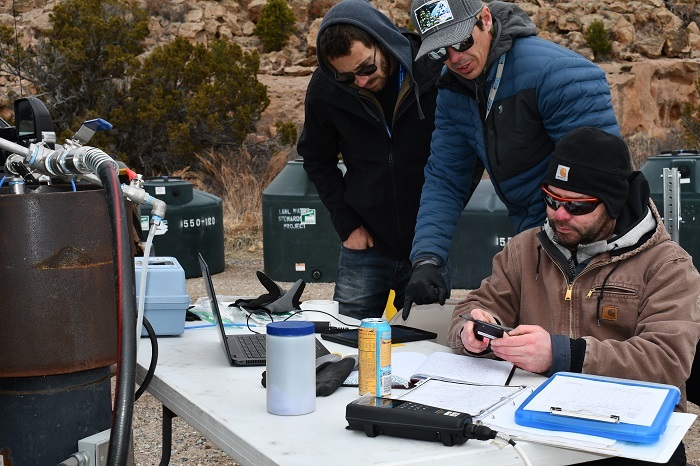 Groundwater monitoring studies began in 1945 at Los Alamos National Laboratory (LANL). Today, workers collect nearly 2,300 groundwater samples annually. The groundwater samples are collected from a network of more than 200 monitoring wells located on LANL, Pueblo de San Ildefonso, Los Alamos County and Santa Fe County property. The sampling helps ensure water drawn for human consumption meets all federal and state drinking water standards.
LOS ALAMOS, N.M. — EM Los Alamos Field Office (EM-LA) crews collected more than 8,670 soil, sediment, surface water and groundwater samples in 2023.
Results from the samples gathered by EM-LA legacy waste cleanup contractor Newport News Nuclear BWXT Los Alamos (N3B) help guide legacy waste cleanup at Los Alamos National Laboratory (LANL).
“Our robust sampling program helps verify the effectiveness of our legacy waste cleanup operations at LANL,” said Amanda White, director of N3B’s Environmental Remediation Water Program. “The focus and commitment to protecting water supplies is of paramount importance to EM-LA and N3B.”
The U.S. Environmental Protection Agency, state of New Mexico and DOE provide regulatory oversight for surface water, stormwater and groundwater, including water that surfaces through springs.
The surface and groundwater programs are part of N3B’s mission to clean up legacy waste at LANL. In fact, protecting water and the environment is the major reason for cleaning up LANL legacy waste. Those efforts focus on remediating contamination from legacy operations across mesas, canyons and drainages throughout LANL.
Additionally, N3B manages a substantial network of sampling, inspection, controls and treatments across LANL to help ensure the cleanup of legacy waste is effective. Some examples include low-head weirs, berms, detention basins and grade-control structures.
 The low-head weir pictured is one of many storm water controls that help prevent contaminated sediment from being transported downstream. Other types of controls include berms, detention basins and grade-control structures. All are included in an annual maintenance and inspection program.
The numbers are impressive. In 2023, N3B collected 4,000 water samples and 4,670 soil and sediment samples, conducted 5,013 stormwater control inspections, and treated nearly 23 million gallons of groundwater to remove hexavalent chromium.
“Since some of our sampling is of stormwater and sediment mobilized in stormwater, the challenge is never knowing when, where and how much it is going to rain,” N3B Surface Water and Stormwater Manager Karly Rodriguez said.
N3B Groundwater Monitoring Manager Keith McIntyre added that access to many of the sampling sites is also an issue.
“Thunderstorms, snow and ice, washed out roads, as well as operational access because of sensitive work, can make collecting samples a challenge,” he said.
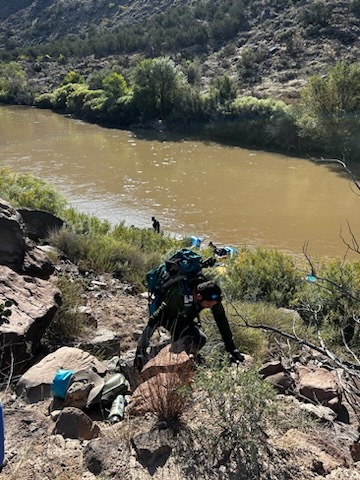 |
|
The safest way to collect annual groundwater, surface water and sediment samples near the point of entry into the Rio Grande is from the river side of the massive White Rock Canyon. Water access for the sampling crews, equipment and samples is much safer than traversing the steep, rugged and isolated canyon walls. |
Newport News Nuclear BWXT Los Alamos is upgrading its older radio telemetry system, pictured, to a more reliable satellite-based telemetry system. The new system will allow expansion of automated sample collection and data transfer capabilities in remote and hard-to-reach areas. |
|
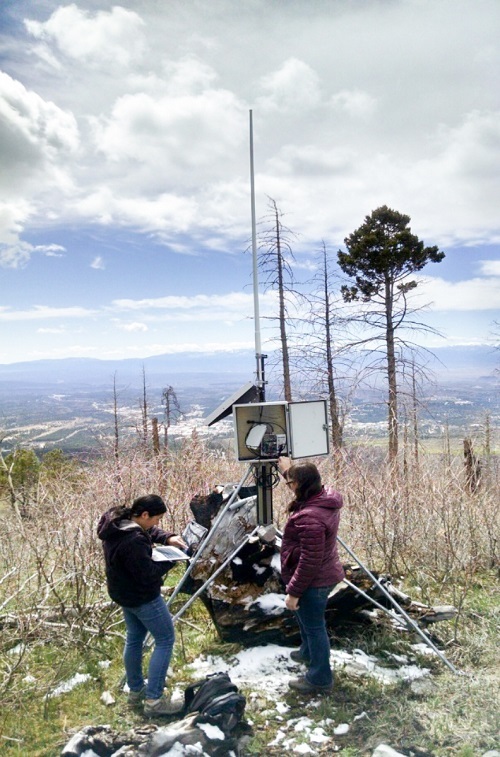 |
Due to Los Alamos’ rugged terrain and the remoteness of some sampling sites, using the latest technology is critical to meeting the commitment to protect water supplies.
“To help meet that commitment, we now have about 250 locations where we use automated stormwater samplers programmed to collect samples during storm events. Since stormflow is high intensity and of a short duration, automated samplers are critical to collecting samples,” Rodriguez said.
White added, “Protecting the environment, especially water, is our priority in cleaning up legacy waste at LANL and ensuring water quality objectives are met.”
-Contributors: David Abelson, Todd Nelson
 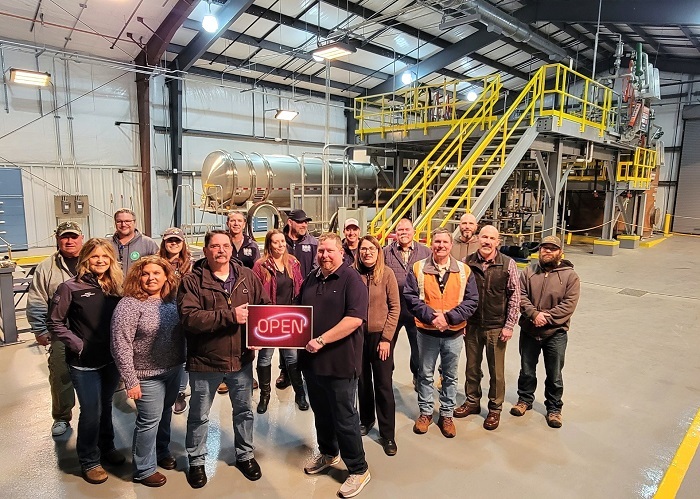 After two years of renovations and upgrades, the Hanford Site’s Effluent Treatment Facility load-in station is open for business.
RICHLAND, Wash. — In an integral step toward preparing for tank waste treatment on the Hanford Site, the newly renovated load-in station at the Effluent Treatment Facility (ETF) recently reopened for business.
Over the past two years, Hanford tank operations contractor Washington River Protection Solutions upgraded and expanded the load-in station to prepare for the added wastewater demands of the Direct-Feed Low-Activity Waste (DFLAW) Program.
“The successful transition from construction and testing to operations is another important step toward treating tank waste, a top Hanford priority,” said Will Ruane, Hanford’s ETF program manager. “The upgrades boost efficiency and dependability to ensure the facility can handle the increased wastewater capacity the Direct-Feed Low-Activity Waste Program will require.”
 The Hanford Site’s Effluent Treatment Facility load-in station during, left, and after expansion and upgrades.
The ETF load-in station receives wastewater shipments via tanker trucks from various work projects around the Hanford Site in addition to what will come from DFLAW operations. The wastewater is pumped from the load-in station and then to Hanford’s Liquid Effluent Retention Facility for storage before eventual processing at the ETF.
During renovations, the interior of the load-in station was gutted and all new piping, electrical and mechanical equipment was installed. A new offloading platform was added to allow safer and easier operator access to the tankers. The modifications also enable an additional tanker to prepare for unloading while another tanker is being emptied. The load-in station was also extended by 30 feet to accommodate larger tanker trucks.
“We’re proud of the tireless effort of all our construction teams, craftsmen, testing staff and operators,” said Rob Wood, Washington River Protection Solutions ETF load-in station project manager. “The renovated load-in station prepares us for and will support 24/7 operations on the Hanford Site.”
One of the first tankers to unload at the station will be from the K West Reactor spent-fuel storage basin. Contaminated water will be pumped out of the 1.2-million-gallon basin, filtered and transported to ETF for processing and disposal beginning next month.
-Contributor: Joan Lucas
  Metal debris generated during decontamination and demolition activities at the Naval Reactors Facility is transported to a regional small business for recycling.
IDAHO FALLS, Idaho — EM is achieving its environmental and sustainability goals as it demolishes two legacy nuclear reactors at the Idaho National Laboratory (INL) Site.
Since 2022, when EM’s INL Site contractor, Idaho Environmental Coalition (IEC), began decontamination and demolition (D&D) activities on the Submarine 1st Generation Westinghouse (S1W) and the Aircraft Carrier 1st Generation Westinghouse (A1W) reactor prototypes at the Naval Reactors Facility at the INL Site, recycling and waste minimization have been high priorities.
D&D crews have made great strides to ensure safe recycling practices are used to properly dispose of non-contaminated waste, including lead, copper, brass, bronze, carbon steel, aluminum and stainless steel. IEC also hired a regional small recycling business to collect clean metal from the projects and transport the material to a larger recycler in Salt Lake City, Utah.
Since the beginning of the project, 342 tons of debris and scrap metal have been recycled, diverting about 864 cubic yards of material from being disposed of in a landfill. In addition, recycling metal offsets 581 tons of carbon dioxide emissions that would result from the production of new metal.
While these environmental successes are significant, the project also generated approximately $463,000 in cost savings.
“The D&D efforts at the Naval Reactors Facility have been very successful in protecting employees, achieving recycling goals and reducing the environmental footprint,” said IEC D&D Projects Operations Director Mike Swartz.
The S1W and A1W prototypes were shut down by the Navy in 1989 and 1994, respectively, and played a significant role in training and developing the nation’s nuclear fleet. The S1W reactor was the prototype for the world’s first nuclear powered submarine, the USS NAUTILUS, and the A1W was the prototype for the first nuclear-powered surface ship and aircraft carrier, the USS LONG BEACH and the USS ENTERPRISE.
IEC anticipates completing D&D efforts at the S1W prototype next year. It is expected that D&D work at the A1W prototype, which began in the summer of 2023, will be completed approximately two years after.
Swartz said he is proud to be part of a project that focuses on completion, while protecting the environment and partnering with small businesses. It will become a model for the company as it progresses.
“The lessons we have learned will be applied to future D&D efforts to the benefit of the project and the public,” he said.
-Contributor: Carter Harrison
 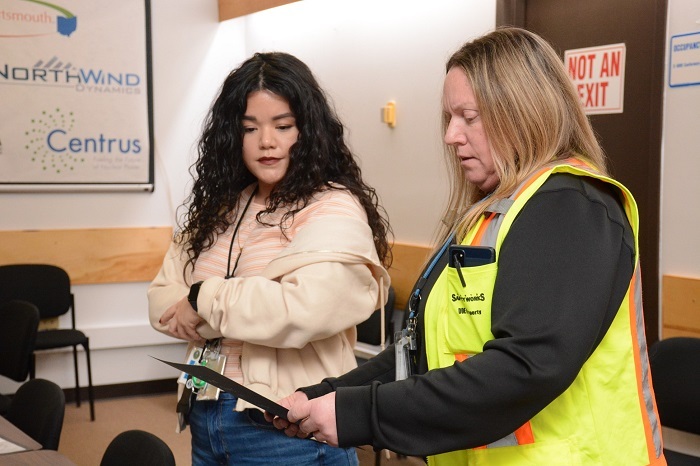 Diversity Council members Shana Lawhorn, left, and Carla Salisbury judge entries in the Portsmouth Site Diversity Council Dr. Martin Luther King Jr. Art Contest. More than 40 high school and junior high school students participated in this year’s event. Students were encouraged to create artwork supporting the theme, “Be the Love in Your Community.” Prizes were awarded for first, second and third places in two age categories.
PIKE COUNTY, Ohio — A diversity council created at EM’s Portsmouth Site in 2017 has seen substantial growth and opportunities as it works to create a more inclusive environment through outreach and education.
“The Diversity Council plays a significant role onsite as we continue to break down barriers and provide new opportunities for conversations,” Council Co-Chair Tonia Brown said. “When we open our workforce to additional opportunities for all, we receive a wider range of sources and experiences from a diverse population. This leads to better educated decisions and results.”
Fluor-BWXT-Portsmouth (FBP), EM’s deactivation and demolition contractor at the Portsmouth Site, formed the council to increase discussions on diversity, equity and inclusion, and initiate actions throughout the site and in the community.
Made up of 20 volunteers, the group implements site outreach through meet and greet events, communication and employee community involvement.
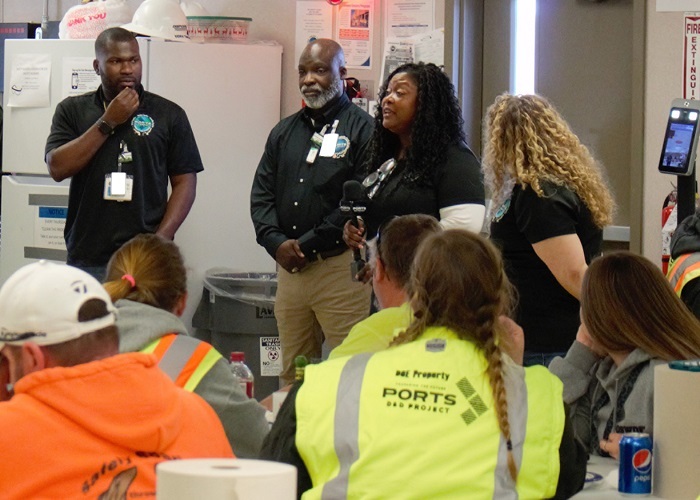 Diversity Council meet and greet events are popular with Portsmouth Site employees. The council provides lunch and organizes icebreaker games to bring co-workers closer together. During these events, the group shares information about what the council does onsite and encourages future conversations.
The council was given its first budget last year and used the opportunity to bring awareness to its onsite work and expand its reach to the local community. The impact can be seen through a pair of $2,000 scholarships to graduating high school seniors, sponsoring the Portsmouth Site Diversity Council Dr. Martin Luther King Jr. Art Contest for local high school and junior high students, and supporting local charitable events, including purchasing Christmas gifts for children at a local community center.
“I believe the Diversity Council has led to a great awareness in the importance of diversity and the need to create inclusive environments where everyone feels valued and respected,” Brown said. “The future of diversity is one in which we recognize and celebrate our differences while also finding common ground and shared values.”
Those who have been a part of the group from the beginning say the growth and impact are making a difference at the Portsmouth Site and in the community.
“We are reaching a point where we don’t tiptoe around subjects by holding honest, open conversations,” said Madenia Stafford, FBP Human Resources director and founding Diversity Council member. “It’s become standard to consider things like bias, opportunities and inclusion in many of our human resources and communication practices that were less visible to us in earlier years. We are slowly but surely becoming intentional in the decisions and actions we take.”
-Contributor: Cindi Remy
 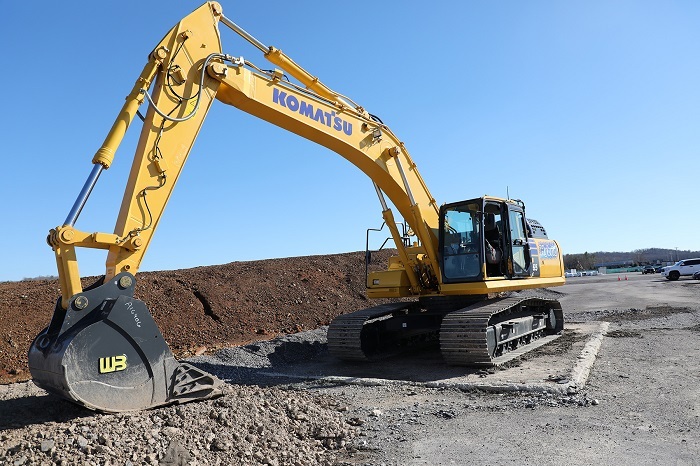 Employees recently conducted a demonstration of this hybrid excavator at the East Tennessee Technology Park. The equipment offers more efficiency, and it also operates much more quietly than current equipment.
Addition of hybrid equipment that breaks ground would be groundbreaking for Oak Ridge cleanup
OAK RIDGE, Tenn. — Developing more sustainable ways to perform work is a continuous focus on DOE’s Oak Ridge Reservation.
The Oak Ridge Office of Environmental Management (OREM) and contractor UCOR made major contributions to help EM reach last year’s goal to bring at least 150 electric vehicles to the cleanup program’s fleet.
This year, OREM and UCOR have their sights set on bigger goals and bigger vehicles.
Previous initiatives focused on passenger fleet vehicles and computer equipment. Now, UCOR is exploring ways to introduce more sustainable equipment to field operations.
Team members just performed a demonstration of a hybrid excavator, and UCOR is considering adding it to the equipment lineup. The excavator has both a diesel and electric engine. The concept is similar to a hybrid car, but as the equipment rotates, a swinging movement charges the electric motor.
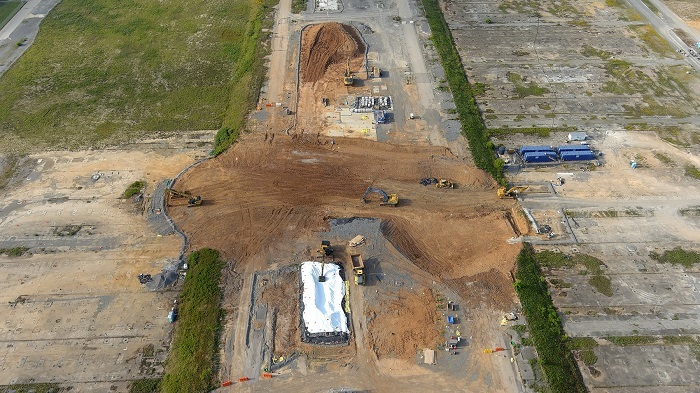 The Oak Ridge Office of Environmental Management’s projects at the East Tennessee Technology Park have involved substantial excavation. That work is scheduled to be completed this year, but much more remains at Oak Ridge National Laboratory and Y-12 National Security Complex in the years ahead.
“This piece of technology enhances production and embodies sustainability, and the workers really like using it,” said Leah Beckworth, UCOR environmental compliance and sustainability manager.
She also points out that the hybrid excavator provides an extra safety feature because it operates much more quietly than conventional heavy equipment.
UCOR performed the demonstration at the East Tennessee Technology Park (ETTP), where crews are completing major soil remediation efforts requiring a great deal of excavation.
Finishing soil remediation projects there is an EM priority for 2024, and there is much more work ahead at the Oak Ridge National Laboratory and Y-12 National Security Complex requiring heavy equipment.
“One of the things that struck me the most is the efficiency,” said Jimmy Hughes, area project manager for the ETTP enterprise. “Often these machines are considered the one-trick pony of being more sustainable. But with the instant power ability as well as the more efficient swinging ability of this machine, it would equate into our crews being able to load debris and move it offsite quicker.”
The contractor’s equipment vendor is working to get some hybrid machines added to its lease fleet. With the positive results of the demonstration, officials say leasing this type of equipment in the future is likely.
-Contributor: Wayne McKinney
  Security Police Officer Cody Burger and canine Tarzan conduct an explosives search on a vehicle at the United States Police Canine Association Region 2 Spring Detection Trials. Tarzan and the other Savannah River Site canines are trained to sit when they detect the odor of potential explosive materials, and are then rewarded with a toy after a successful detection.
AIKEN, S.C. — The award-winning Savannah River Site (SRS) Canine Program helped host 27 teams from South Carolina and North Carolina as they participated in annual trials of the nation’s oldest and largest police canine organization.
The United States Police Canine Association conducted its spring canine detection trials for the region at SRS. The event was jointly hosted by the SRS Law Enforcement Department, Aiken County Sheriff’s Office and Aiken Department of Public Safety.
“Centerra has hosted this event with local law enforcement for over 20 years,” said Norris Bunch, supervisor of the canine section of security services contractor Centerra-SRS. “During the trials, participating canine teams are evaluated based on a measured level of proficiency that must be maintained for certification. Each team must demonstrate through various testing events an ability to meet the required standards.”
While the association held explosive detection training and certification at SRS, the narcotics detection training and certification, and cadaver search certification were held at several locations in Aiken.
As the universally accepted certification authority for canine working teams, the association has testing procedures that follow currently accepted police canine practices. To test fairly, law enforcement canine professionals serve as evaluators to observe and document canine team performance.
During trials, narcotics and explosives test sources are hidden on vehicles or in packages and the canine teams must successfully locate the items within a designated time period. Certification of a working canine team is an indicator of successful training and that the team is capable of successfully performing its assigned mission, whether it be explosives, narcotics or cadaver detection.
“Canine teams must be initially tested and certified before being deployed at SRS. After certification, handlers and their dogs are retested on an annual basis to ensure they maintain the proper fundamentals of training and technique,” added Bunch. “At these local trials, all of our SRS canine teams once again achieved certification.”
The SRS Canine Program has earned numerous local, regional and national awards over the years and has been called upon to support local law enforcement and federal agencies, when site missions allow.
“The Canine Program is an important element of our overall security posture at the site and we train constantly to ensure that we maintain a high level of proficiency,” said Bunch. “As a result, we have a very effective and efficient canine program that is fully capable of providing explosives and narcotics detection support at any time.”
-Contributor: Audrey Barron, Rob Davis
  EM crews demolish the former Waste Reduction and Packaging Area at the West Valley Demonstration Project.
WEST VALLEY, N.Y. — An EM team safely demolished a structure at West Valley Demonstration Project used during former spent nuclear fuel reprocessing operations as well as cleanup, including solidification of liquid high-level waste and deactivation of one of the last major facilities remaining at the site.
“The West Valley Demonstration Project team strives to find solutions to conduct demolition activities in a safe, efficient and deliberate manner,” said Stephen Bousquet, assistant director of West Valley’s Office of Project Management. “They continue to leverage their combined knowledge and expertise to complete the demolition of this major milestone safely and compliantly.”
The crews demolished the 1,000-square-foot Waste Reduction and Packaging Area along with an associated dock about 600 square feet in area. Both structures were used to package waste and ship it offsite for disposal. At one time, a box compactor was used to compact waste inside metal waste boxes to maximize the waste content of the boxes.
Demolition began at the end of January, and the building structure and dock were demolished over two days. Workers used a large excavator with a hydraulic shear attachment to take down the building.
“The completion of this demolition demonstrates the commitment to identifying efficiencies while maintaining a safe and compliant approach to the overall demolition of the Main Plant,” said Tom Dogal, Facility Disposition director with EM cleanup contractor CH2M HILL BWXT West Valley. “It is collaborations like this, between the workforce, management and DOE, that is making the project such a success.”
Successful demolition of the Main Plant Process Building will further reduce environmental risks and position the site for the next phase in cleanup. The demolition is expected to be completed in the fiscal year that begins this October.
-Contributor: Joseph Pillittere
 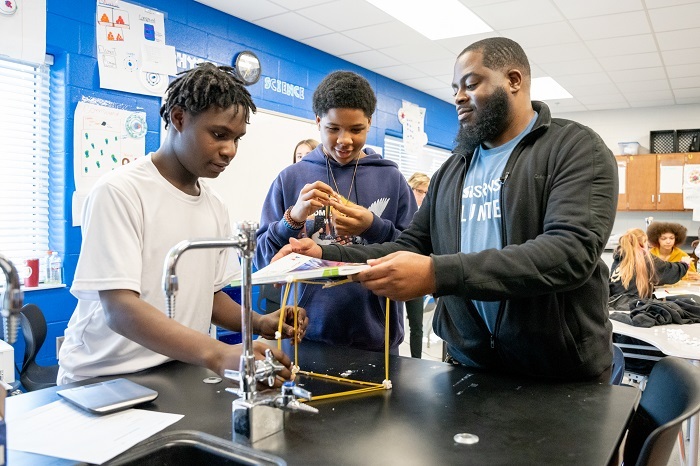 Savannah River Nuclear Solutions Engineer and volunteer Terry Wilder, right, assists Murphey Middle School students Tyrrell Yeldell, left, and Kelvon Williams with the “Leaning Tower of Pasta” activity focused on design engineering techniques.
AIKEN, S.C. — Forty engineers at the Savannah River Site (SRS) recently helped 1,484 area middle school students explore engineering with 72 hands-on activities.
Formerly known as “Engineering Teach-Ins,” “Discover Engineering” highlights how engineering impacts the world from the perspective of engineers. Since the outreach program’s start in 2008, SRS volunteers have gone into classrooms where they’ve spent thousands of hours focusing on science, technology, engineering and math (STEM) with more than 30,000 students.
“This is a major opportunity to expose students to the world of engineering,” said Taylor Rice, Education Outreach specialist for Savannah River Nuclear Solutions (SRNS), the site’s managing and operating contractor. “Our partnership with local schools continues to spark interest in our most needed scientific and technical careers. It supports a growing and viable workforce.”
 |
|
In a centerpiece story last week, EM Update spotlighted five engineers across the cleanup complex for National Engineers Week. Read it here:
|
SRNS Engineer Terry Wilder volunteered at Murphey Middle School and led an activity called “Leaning Tower of Pasta,” teaching students the importance of structural design engineering.
“I truly enjoy connecting with the next generation of future leaders,” said Wilder. “Engineering is a promising career option in a world where students tend to idolize professional athletes, celebrities and social media influencers. These activities show students key elements that we look for in our future engineers and that this career could be the perfect fit for them.”
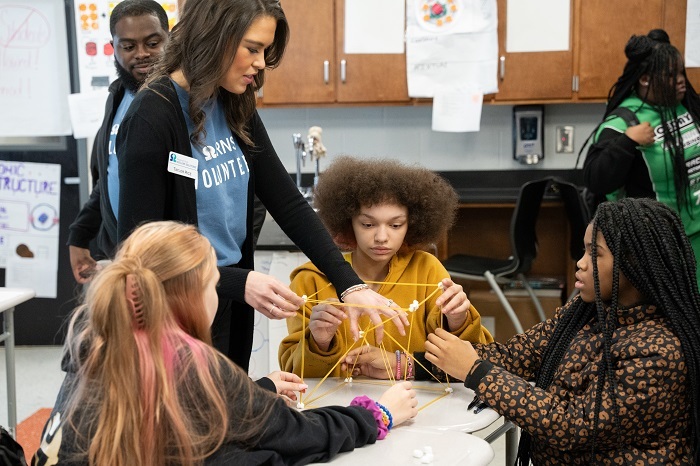 Savannah River Nuclear Solutions Education Outreach Specialist Taylor Rice assists Murphey Middle School students in building a structure made from spaghetti and marshmallows.
Tyrrell Yeldell, an eighth grader at the school, noted that engineers are critical to building safety. The event also inspired him to consider a computer engineering career.
“Although my group struggled to build a spaghetti structure that could withstand the pressure of the textbooks, I realized how important engineers are to the world and the safety of buildings all around us,” Yeldell said. “I love Minecraft and working with computers. Terry showed me how I can transform these talents into a computer engineering career.”
In conjunction with National Engineers Week, the demonstrations are part of DiscoverE, which celebrates the contributions of engineers worldwide. SRNS volunteers covered engineering degrees, average salaries, recommended courses, extracurricular activities and other ways students can plan for early success.
Tanya Redic, a science instructor at Murphey Middle School, was amazed at the opportunities SRS has provided local schools since becoming a science teacher nearly 20 years ago.
“This program is the engine that will drive my students in the right direction to become future scientists, engineers and mathematicians,” said Redic. “SRS is making a difference and helping students pursue bigger dreams.”
SRNS Education Outreach provides a variety of science and engineering outreach programs with the goals of drawing interest in STEM and improving education in the local community. For more information about these programs, click here.
-Contributor: Mackenzie McNabb
 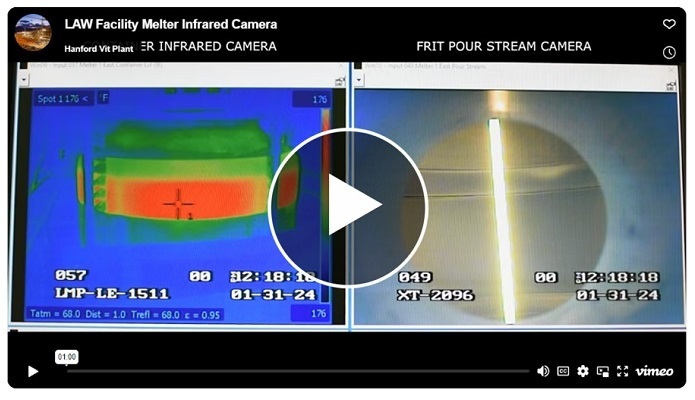 In this video, a camera captures the path of the molten glass as it enters a stainless steel container, right, while an infrared camera shows the rising temperature of the container in real time, left.
RICHLAND, Wash. — Workers at the Hanford Site‘s Waste Treatment and Immobilization Plant (WTP) recently poured test glass into four stainless steel containers inside the plant’s Low-Activity Waste (LAW) Facility. The pours help crews build proficiency for future tank waste treatment operations.
“As the team prepares to heat up Melter 2, our operations team conducts continual proficiency test pours,” said Mat Irwin, acting assistant manager for WTP. “We speak to the importance of the people, plant and paper all being prepared as we near cold commissioning, and each of these pours is another step toward safe and sustained operations.”
Last summer, WTP staff heated up the first of two melters to 2,100 degrees Fahrenheit and began filling the melter with glass beads, called frit. The frit melts and forms a molten test glass that is poured into containers. The test glass is “clean,” as it does not include any chemicals or radiological waste.
That process, called cold commissioning, will also be completed with Melter 2, allowing workers to operate the plant and immobilize the simulated waste in glass without the hazards of real waste.
EM contractor Bechtel National Inc. is designing, constructing and commissioning the plant for Hanford. When complete, the plant will stabilize millions of gallons of pretreated tank waste using a process known as vitrification, during which the waste will be mixed with glass-forming materials in the 300-ton melters, poured into the containers and transferred to Hanford’s Integrated Disposal Facility for safe disposal.
Bechtel anticipates heating up the second melter in the coming weeks. Information on the melter heatup process can be found at Journey to Melter Heatup. The plant facilities can be viewed using the self-guided Hanford Virtual Tour.
-Contributor: Tyler Oates
|







